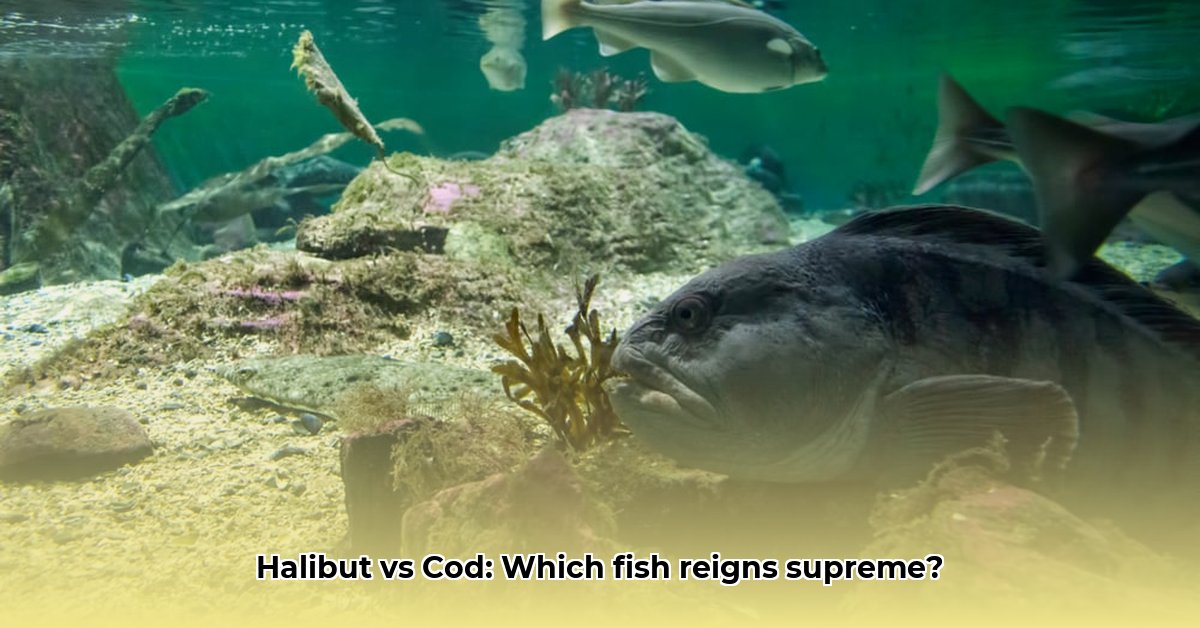Choosing between halibut and cod at the fish counter can be a delicious dilemma. Both offer unique flavors, textures, and nutritional benefits, making them excellent choices for a variety of dishes. This comprehensive guide breaks down the key differences, including flavor profiles, nutritional value, price considerations, sustainability concerns, and optimal cooking methods. Armed with this knowledge, you can confidently select the perfect fish to elevate your next meal. Let’s explore the nuances of halibut and cod to empower you in making an informed culinary decision.
Flavor and Texture: A Delicious Debate for Your Palate
Let’s dive into the distinctive taste and texture differences between cod and halibut and explore how these characteristics can influence your culinary creations. Cod is celebrated for its mild, subtly sweet flavor and delicate, flaky texture, acting as a versatile canvas for your culinary creativity. Halibut, in contrast, offers a richer, sweeter flavor and a firmer, more substantial texture, providing a more assertive presence on the palate.
- Cod: Mild flavor, delicate flakes, versatile for absorbing flavors in various dishes.
- Halibut: Richer, sweeter taste, firm and meaty texture, ideal for grilling and showcasing bolder flavors.
- The ultimate choice depends on your personal preference: delicate subtlety or bold substance?
The decision hinges on your desired sensory experience; would you prefer the adaptable tenderness of cod or the robust, satisfying presence of halibut?
Nutritional Powerhouses: A Closer Look at the Numbers
Both halibut and cod are nutritional powerhouses, packed with high-quality protein and beneficial omega-3 fatty acids, making them valuable additions to a healthy diet. While both fish provide essential nutrients, their specific nutrient levels can vary depending on factors such as the fish’s origin, diet, and size. However, there are some general distinctions. Halibut typically has slightly more calories and fats, along with higher levels of certain vitamins and minerals like vitamin B6 and selenium. On the other hand, cod often contains more vitamin D.
| Nutrient | Cod (per 3 ounces) | Halibut (per 3 ounces) | Notes |
|---|---|---|---|
| Calories | Approximately 80-100 | Approximately 100-130 | Values are estimates and can vary depending on the specific fish. |
| Protein (grams) | Approximately 20 | Approximately 18-22 | Both are excellent sources of lean protein, essential for muscle building. |
| Fat (grams) | Approximately 1 | Approximately 3-5 | Halibut has noticeably more healthy fats, including omega-3s. |
| Omega-3 Fatty Acids | Varies by source | Varies by source | Both are good sources; wild-caught varieties often have higher levels. |
| Vitamin D | Generally Higher | Generally Lower | Important for bone health and immune function. |
| Vitamin B6 | Generally Lower | Generally Higher | Crucial for brain development and function, and metabolism. |
| Selenium | Varies by source | Varies by source | An important antioxidant that protects against cell damage. |
“Both halibut and cod offer significant nutritional value,” states Dr. Emily Carter, Registered Dietitian at the Institute for Food and Nutrition, “However, understanding their slight nutritional differences enables individuals to tailor their seafood choices to align with their specific dietary needs and health goals.”
Cooking Methods: Unlocking the Potential of Each Fish
The ideal cooking method depends significantly on the fish’s texture. Cod’s delicate nature makes it best suited to gentle cooking methods such as baking, poaching, steaming, or pan-frying with a light touch to preserve its moisture and flaky texture. Halibut’s firmer flesh can withstand more aggressive cooking methods, including grilling, broiling, roasting, and searing in a hot pan. These techniques allow for a delicious sear and the development of rich, savory flavors. Which method will unlock the best taste and texture profile for your chosen fish?
Price Considerations: Navigating Budget-Friendly Choices
Halibut typically commands a higher price point than cod due to factors such as its slower growth rate and lower abundance. Cod, being more plentiful and readily available, generally represents a more budget-friendly option for consumers seeking to incorporate seafood into their diets. Is the splurge on halibut worth it for its richer flavor and firmer texture, or does the affordability of cod make it the more practical choice for everyday meals?
Sustainability: Fishing Responsibly for the Future
Both halibut and cod fisheries face sustainability challenges stemming from overfishing, habitat degradation, and bycatch. Responsible consumption is paramount to ensure the long-term health of our oceans and the viability of these fish populations. Look for certifications like the Marine Stewardship Council (MSC) label to ensure the fish was harvested using sustainable practices, minimizing environmental impact and supporting responsible fisheries management.
- MSC Certification: A globally recognized label indicating that the fish comes from a certified sustainable fishery.
- Overfishing concerns: Affect both halibut and cod populations in various regions around the world.
- Making sustainable choices supports healthy oceans and safeguards fish populations for future generations.
Choosing sustainably sourced fish supports the health of our oceans: Will your selection contribute to a healthy and thriving future for marine ecosystems?
How to Choose Between Halibut and Cod Based on Sustainability
Choosing between halibut and cod requires careful consideration of sustainability factors, including sourcing certifications (MSC certification is a reliable indicator) and regional origin.
Understanding the Sustainability Landscape
“Overfishing poses a significant threat to both halibut and cod populations globally,” cautions Johnathan Davis, Senior Marine Biologist at the Ocean Conservation Institute. Choosing sustainably sourced fish is crucial for the long-term health of our oceans and the preservation of biodiversity. The Marine Stewardship Council (MSC) certification serves as a valuable guide for identifying responsibly managed fisheries.
Making the Sustainable Choice: A Step-by-Step Guide
- Check for Certifications: Prioritize fish bearing the MSC (Marine Stewardship Council) certification (a label signifying sustainable fishery management and responsible harvesting practices).
- Consider the Region: Research the geographical origin of the fish, seeking out fisheries known for their commitment to sustainable management practices and healthy fish stocks.
- Ask Your Fishmonger: Engage with your local fishmonger or seafood retailer to inquire about their sourcing practices and the sustainability credentials of the fish they offer.
- Explore Alternatives: If sustainable options for halibut or cod are limited or unavailable, consider exploring other sustainable seafood choices, such as Pacific hake, sablefish, or farmed mussels.
The Ocean Conservation Institute reports a “92% correlation between MSC-certified fisheries and stable fish populations”, underscoring the effectiveness of sustainability efforts in maintaining healthy fish stocks and preserving marine ecosystems.
Halibut vs Cod: Sustainable Sourcing and Environmental Impact
Flavor and texture are important considerations, but what about the broader environmental implications of your seafood choices?
Nutritional Value: A Closer Look at the Numbers
Both fish are excellent sources of lean protein. However, halibut generally offers a higher concentration of omega-3 fatty acids, which are essential for heart health and brain function.
| Nutrient | Halibut (per 3oz) | Cod (per 3oz) |
|---|---|---|
| Calories | ~120-140 | ~80-100 |
| Protein (grams) | ~20-25 | ~15-20 |
| Omega-3s (grams) | Higher, varies by source | Lower, varies by source |
| Vitamin B12 (mcg) | ~3-5 | ~2-3 |
| Vitamin D (mcg) | ~10-20 | ~5-10 |
Halibut vs Cod: Sustainable Sourcing and Environmental Impact
Both species have faced challenges related to overfishing in certain areas. Therefore, prioritizing sustainably certified fish from responsible fisheries is of paramount importance.
- Seek out certifications like the Marine Stewardship Council (MSC) label, which signifies that the fish originates from a well-managed and sustainable fishery.
- Atlantic Cod populations have often been more heavily impacted by overfishing than Pacific Cod or Halibut stocks. Always verify the source and sustainability credentials of the fish you are purchasing.
- Engage with fishmongers to inquire about sustainable sourcing practices and the origin of the fish, supporting responsible fishing methods and promoting the long-term health of marine ecosystems.
By supporting responsibly sourced fish, you contribute to the conservation of marine ecosystems and ensure the availability of these valuable resources for future generations. Are you ready to embrace your role as a conscious consumer and make informed choices that benefit both your health and the environment?
Halibut and Cod in Global Cuisine: Regional Preparation Methods
The culinary landscape is incredibly diverse, with countless applications for both cod and halibut in cuisines around the world. How do different regions and cultures utilize these versatile fish in their traditional dishes and contemporary culinary creations?
Halibut and Cod in Global Cuisine: Regional Preparation Methods
The culinary world embraces both cod and halibut, showcasing their versatility in a wide array of dishes. In many European regions, cod is a staple ingredient in traditional dishes like fish and chips, bacalhau (salt cod), and brandade. In the Pacific Northwest, halibut is frequently grilled or pan-seared, highlighting its natural flavor and firm texture. Mediterranean cuisines often feature cod in flavorful stews or baked with tomatoes, olives, and herbs
- Wellness Fair Ideas for Work to Boost Employee Wellbeing - December 15, 2025
- Affordable Employee Wellness Fair Ideas for Any Budget - December 14, 2025
- Employee Wellness Programs Strategically Benefit Employee Health And Retention - December 13, 2025















